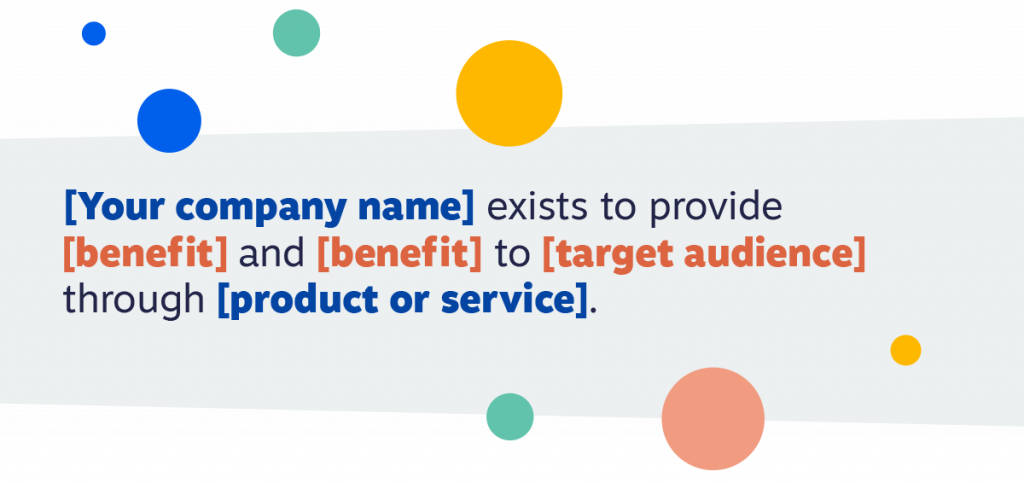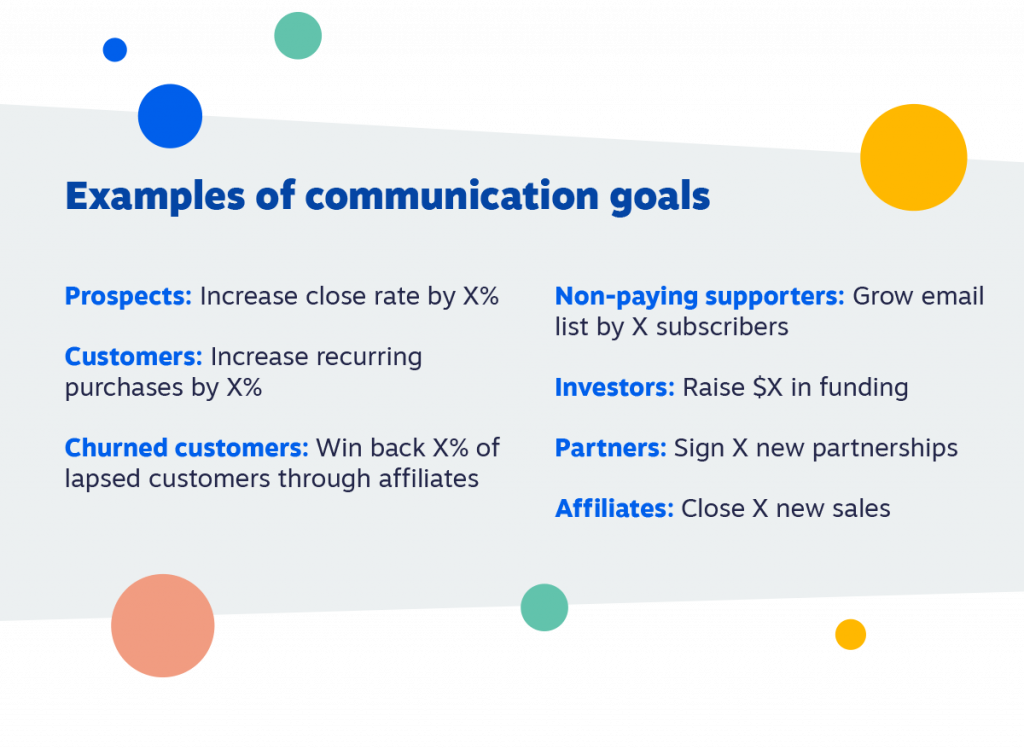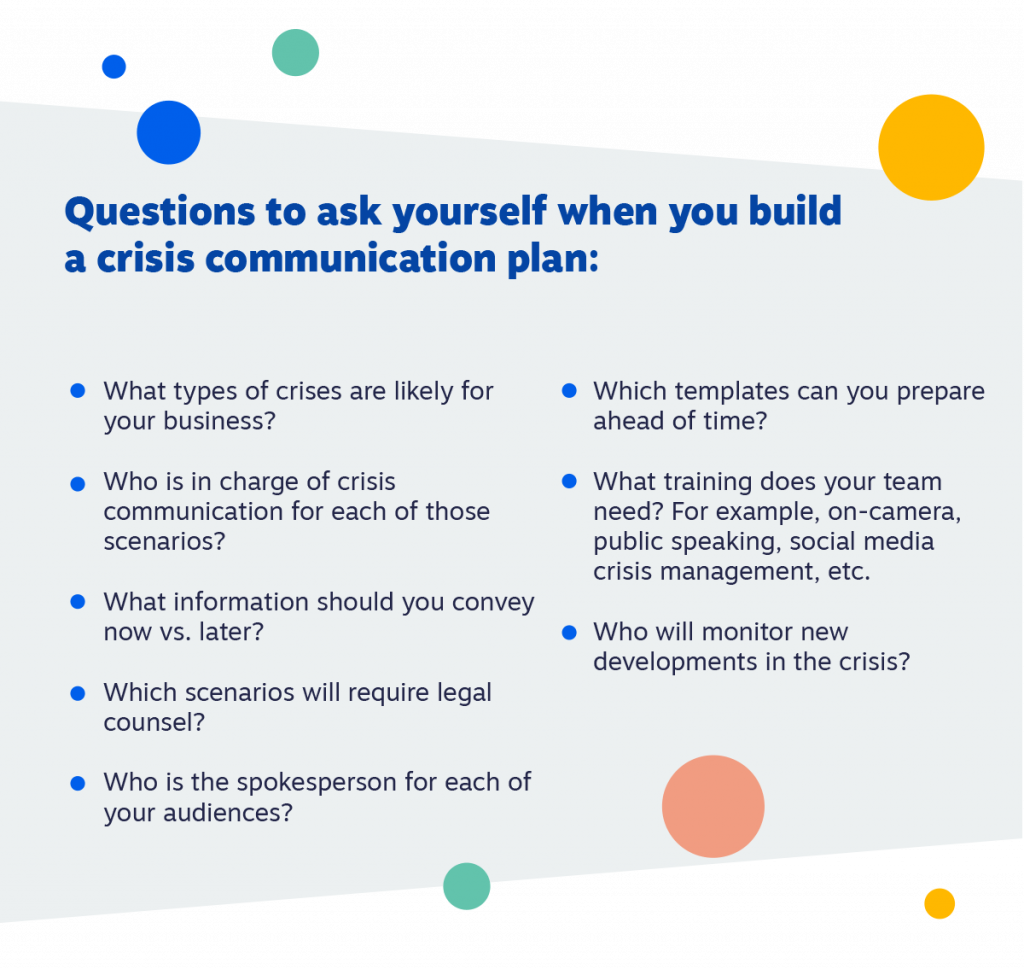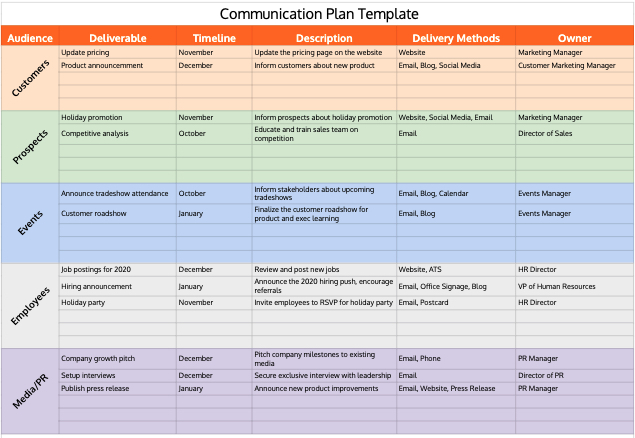A strong communication plan defines strategies and processes that help you capture the attention of people outside of your company.
Creating and maintaining these external relationships is crucial because your company doesn’t exist in a vacuum. Instead, it depends on what your prospects, customers, investors, and partners think of you—and say about you.
Sound like a challenge? That’s because it is.
Think about it. Depending on your market, there could be hundreds of these external stakeholder relationships.
You can’t leave this to chance. It would mean you’re leaving your company’s future to chance, too.
Instead, you can use a communication plan template. It’s a simple yet powerful tool that helps you deliver the right messages to all the audiences that matter to you.
With this template, you’ll never have to think on the spot. You’ll have a document that guides you through every external communication scenario.
Here are the steps to create your communication plan template:
- Create a mission statement
- Define your company’s business objectives
- Identify audience segments for your communication plan
- Establish your communication plan goals
- Define your USP—your competitive advantage
- Develop key messages for each audience segment
- Select channels and frequency for each audience segment
- Assign key stakeholders to each audience and channel
- Identify key company and industry events as triggers
- Create an internal distribution plan
- Create a training plan for audience-facing teams
- Develop an emergency/crisis communication plan
- Establish a feedback loop
- Define a timeline for communication plan refresh
- Determine what success looks like
What should a communications plan include?
As you’ll soon learn, your communication plan template will always evolve. Your business communication process will keep getting better.
At the very minimum, here’s what your communication plan must include:
- Summary
- Your company’s business objectives
- Communication goals
- USP (unique selling proposition)
- Key audiences, messages, and communication channels
- Key stakeholders
- Main company and industry events
- Emergency communication plan
- Review and refresh timelines
Your communication plan shouldn’t need explanations or extra documentation.
Instead, it should enable anyone involved in external communication to make the best decision for your company, all on their own.
The best communication strategy clarifies everyone’s role in your communication goals. A bonus benefit of this strategic, transparent approach? It will improve internal communication as well.
Related: 4 Business Communication Styles and How to Work With Them
How do you develop a communication plan? [15 steps]
Step 1: Create a mission statement

You want all your external communication to be hyper-aligned, right? Starting with a mission statement is the first step to make that possible.
Your mission statement is a short, written description of why your company exists and uniquely serves your market.
When you create your mission statement, it’s not to be forgotten in a drawer. Your goal should be to integrate it into everyone’s workflow. This way, everyone will have the same big picture in mind whether they’re talking to a supplier or a new potential customer.
Consider these examples:
- Tesla: “To accelerate the world’s transition to sustainable energy.”
- LinkedIn: “Connect the world’s professionals to make them more productive and successful.”
This means that when the Tesla staff meet with external partners, their conversations will be driven by sustainable energy rather than, say, maximum cost savings.
Fill in the blanks to create your mission statement:
“[Your company name] exists to provide [benefit] and [benefit] to [target audience] through [product or service].”
Step 2: Define your company’s business objectives
What is it that you want to achieve as a company? These aren’t just tied to your business communication efforts, but also the result of everyone’s overall work.
Business objectives take your mission statement to a tangible, measurable level. They help team members set realistic goals that contribute to those objectives.
Without them, everyone will be working with their version of your company’s future.
That includes the way they communicate, too!
Some examples of business objectives are:
- Increased profit margins by X%
- Reduced churn rate by X%
- Increased customer satisfaction by X%
- XY new customers per month
- Grow yearly revenue by $X
For each business objective you listed in your communication plan, add a note about your communication objective.
This way, it’s easier to get buy-in and track deliverables.
Related: Your Short and Sweet Guide to Business Communication Systems
Step 3: Identify audience segments for your communication plan
It’s time to define audiences you’re looking to impact with your communication plan.
At first thought, you might consider your potential customers. However, the list of people and organizations that impact your company from the outside is probably longer.
Review the following list to identify your audience segments:
- Prospects
- Clients/customers
- Churned clients/customers
- Non-customers that support your organization (event attendees, email subscribers)
- Investors and shareholders
- Partners and sponsors
- Influencers and affiliates
Pick all groups that apply to your organization.
Then, identify the main drivers of connection and support for each of these groups. To do that, you’ll want to answer the following questions:
- What job are they in?
- What are their day-to-day work goals?
- Which challenges do they experience regularly?
- What are their key interests?
- Where do you fit into their big picture?
Use this information to write one paragraph for each audience segment and add it to your communication plan.
Related: 21 Tactical Tips to Uncover Real Customer Insights (Fast)
Step 4: Establish your communication plan goals

In this step, you’re diving deeper from your overall business objectives and into your communication goals.
In simple terms, what do you want your communication to accomplish?
Communication goals should be as specific as possible. This way, you can measure them and optimize your communication strategy accordingly.
Here are some examples based on audience segments from the previous step:
- Prospects: Increase close rate by X%
- Customers: Increase recurring purchases by X%
- Churned customers: Win back X% of lapsed customers
- Non-paying supporters: Grow email list by X subscribers
- Investors: Raise $X in funding
- Partners: Sign X new partnerships
- Affiliates: Close X new sales through affiliates
If you’re struggling to identify communication-specific goals, think of it this way:
Without these goals, you can’t meet your business objectives. Your company is stuck. With them, your communication efforts are the driver of your company’s growth.
Step 5: Define your USP—your competitive advantage
Before you start crafting messages for your audience, think about what makes you unique.
You’ll define this through your unique selling proposition, or USP for short.
A unique selling proposition is a factor that differentiates you from your competitors. You can see it as “what you have that competitors don’t.”
Your USP could be your quality, price range, customer experience, original innovation. It can also be some combination of these.
You can also look at your USP as the context you’ve created around your offering.
Step 6: Develop key messages for each audience segment
This step is where the magic of a communication plan truly comes to life. You’ll now define foundational messages for all of your audience segments.
They’ll act as reference points for all conversations with external people and organizations.
What does this mean?
You’ll develop strong messages when you make sure they are:
- Clear, consistent, and credible
- Focused on the barriers and pain points your target audience is facing
- Delivering a solution you offer for that specific audience and pain point
With this in mind, write out a paragraph of key messages for each of your audiences.
Remember to include your audience’s pain points (in their own words and phrases) in your project plan!
Step 7: Select channels and frequency for each audience segment
Where does your audience like to spend time, both online and otherwise?
What grabs their attention?
How often do they visit those platforms and places?
Answer these questions for each of your audience segments. You’ll end up with an idea of where you need to show up, and how often, to build and nurture key relationships.
The specific answers will depend on your industry, job roles, and other factors, but you can start from this list:
- Blogs, case studies, and other resources on your website
- Emails, both one-on-one and newsletters
- Live events and conferences
- Social media platforms
- Press releases
Another question to help you get the frequency of communication right is:
What’s the longest you can go without communicating with your audience and still stay relevant and top-of-mind?
Make sure you don’t overshoot this time frame without showing up on your platform of choice for that audience.
with unified communications.
Step 8: Assign key stakeholders to each audience and channel
You now know who you want to reach, on which channel, how often, and with which key messages.
Now, you must identify the project team in charge of making sure this actually happens!
First, you’ll want to make sure that each part of your communication plan has its owner. This can be divided by audience segments.
For example, you have a partner relations manager, a customer service manager, etc. Or divided by channels—social media, content, and so on.
It might also be a mix of both depending on your communication needs.
Then, identify all supporting roles so communication can run smoothly, including:
- Writers and editors
- Graphic designers
- Event planners
- Outreach experts
List all the essential roles and assign them to relevant teams and people.
Step 9: Identify key company and industry events as triggers
All markets and industries have their main events and important dates that drive public conversations.
When these dates roll out, it’s already too late to plan any messages and promotions around them. This is why you need to have them laid out as far in advance as possible.
Here’s a list to start brainstorming key dates:
- Your launches
- Product and feature updates
- New funding
- Industry reports and new data
- Beginning or end of a season
- Recurring industry conferences
For example, almost everyone in tech and marketing eagerly awaits for Mary Meeker’s yearly report on internet trends.
Accountants and legal firms depend on changes in legislature.
The sooner you can prepare for an upcoming relevant event, the better you can align all your messaging with it, including your product launches.
Build a calendar with these dates into your communications strategy, and make it easy to update.
Step 10: Create an internal distribution plan
Where will your communication plan live daily?
How will you ensure that everyone in the company always knows where it is and how it serves them—including new hires?
Your communication plan has to be a central document that exists on a shared platform and is easy to access by all company staff. Whether you choose Google Drive, your central project management tool, or something else is entirely up to you.
You should make sure it’s impossible to accidentally find an outdated version and believe it’s the most recent one. Make these obvious:
- Last update date
- Which parts are new or updated from the previous version
Identify a project manager to distribute your communication plan, both when you first roll it out, as well as for each update. The best people for this are usually team leads and managers, who can also offer support when any feedback or questions arise.
Step 11: Create a training plan for audience-facing teams
You have stakeholders for audiences and channels based on their job descriptions and skills.
Now, look into the skillsets of these teams and identify any gaps that might exist.
This isn’t to say they aren’t equipped for their role in your communication strategy. But it’s important to always look out for new skills that may contribute to more effective communication.
For example:
- The customer service team wants to be more efficient in times of increased support queries on social media
- Your traditional PR team wants to win online press mentions with link building outreach
- Or your paid advertising team needs to keep up with platform-specific requirements for ads
Based on the gaps you find, build a training plan for these teams. Make sure you include the budget, experts, topics, and frequency of training.
Step 12: Develop an emergency/crisis communication plan

Emergencies and crises are different for every business.
Social media faux pas, data breaches, bad press, communication breakdowns, product failures, environmental threats… The list of potential disasters is endless.
A crisis communication plan is a crucial part of every disaster preparedness plan. To establish it, answer these questions:
- What types of crises are likely for your business?
- Who is in charge of crisis communication for each of those scenarios?
- What information should you convey now vs. later?
- Which scenarios will require legal counsel?
- Who is the spokesperson for each of your audiences?
- Which templates can you prepare ahead of time?
- What training does your team need? For example, on-camera, public speaking, social media crisis management, etc.
- Who will monitor new developments in the crisis?
Build these answers into your communication plan, so it’s easy to find and reference when it’s needed the most.
Related: How to Create an Airtight Business Continuity Plan in 8 Steps
Step 13: Establish a feedback loop
If there’s a surefire way for your communication plan to fail, it’s this: not asking for or implementing feedback from the field.
Everyone you’ve given a task from this communication plan has a unique exposure to external people and companies you care about.
To make the most out of this, you must establish an easy process for them to document that feedback. If it lives in their head or on a piece of paper, it will never help you make this communication plan better!
Define a frequency at which you will revisit these feedback entries. Then, look for:
- Any patterns in customer complaints
- Opportunities for updates to your products
- Phrases your audiences frequently use that you haven’t identified before
This way, your communication plan will keep evolving as your audiences change!
Step 14: Define a timeline for communication plan refresh
Your communication plan won’t evolve on its own.
Instead, you need to identify a frequency at which you’ll revisit your communication plan. Changes to it will come from the feedback you’ve gathered in the previous step, as well as from industry changes and any new key dates.
You can start with a quarterly update and adjust if you notice it’s too frequent or not frequent enough.
Once you’ve decided on your timeline, make sure you add a note about it in the communication plan itself.
Step 15: Determine what success looks like
How will you know if your communication plan is efficient and successful?
What will indicate failure and the need to make significant changes to it?
First, check back with your business objectives and communication goals. Then, identify the data you need to gather to compare against these goals and objectives:
- Quantitative: revenue, new customers, customer churn rate, website, and social media metrics, etc.
- Qualitative: customer service issues, customer testimonials, feedback from partners, etc.
Take note of current values for all the quantitative metrics as your baseline.
Finally, define the growth trajectory you want to see based on your objectives. Break it down into monthly and quarterly milestones.
Summary
Download the Excel & PDF version of the communications template.
By following this step-by-step communication plan guide, you’ll leave nothing to chance.
The result? An action plan to translate your brand into the right messages for your crucial audiences.
Let’s quickly recap:
- Start with your mission statement and your big-picture business objectives
- Identify your communication goals and your USP
- Put audience segments front-and-center
- Based on them, define key messages, channels, and communication frequency for each
- Follow the most important dates for your company and industry to get the timing right
- Give your key stakeholders them opportunities for training and feedback
- Refresh your communication plan regularly and know what success looks like
Follow this free template, and you’ll have a bulletproof plan for strategic communications. Good luck!
Stop dreaming. It’s here.



